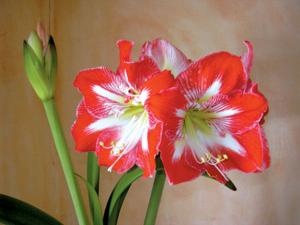Amaryllis are tender perennials
She was a love-struck shepherdess longing for the handsome but cold-hearted Alteo. She visited his cottage every day, piercing her heart with a golden arrow to hide her angst. The drops of blood fell to earth, turning into stunning scarlet flowers. The blood magic worked, and she won over Alteo. Her name was Amaryllis, and today she lends her name to the popular Christmas plant Amaryllis with huge trumpet-shaped flowers.
These South African natives grow from colossal bulbs, sending up long, strap-shaped green leaves followed by leafless spikes topped by several trumpet-shaped flowers. The flowers bloom in shades of pink, red, salmon, white, and orange, as well as striped and double flowers.
Amaryllis, more properly called Hippeastrum, are tender perennials and hardy outdoors only in USDA zones 9 to 11. The bigger the bulb, the more flowers you get. The largest amaryllis bulbs are 14 to 16 inches (36 to 41 cm) in circumference. Each bulb this size produces three or more flower stalks, or scapes (flower stems), with four or more blooms on each stem. Most commercial amaryllis bulbs measure 10 1/2 to 12 1/2 inches (27 to 32 cm) and will grow two stems with up to six flowers on each stem. Often bulbs send up two flower stems at one time, while other bulbs sprout stems several weeks apart.
Water immediately after planting, and then hold off watering until the stem starts to emerge. Once the leaves and bud sprout, you gradually water more often, but don’t let the soil stay soggy. After the stem is done growing, the flowers form. Potted amaryllis bulbs bloom in seven to 10 weeks. For a nonstop show of amaryllis flowers, plant bulbs every two weeks.
Once your amaryllis stops blooming, you can get it to rebloom for several years. To store your bulb for next year, cut off the flowers as they fade and wilt. After all of the flowers are gone, cut the stems back to the top of the bulb.
Keep watering lightly and move it outdoors when all danger of frost is past, or place it in a sunny window. To produce enough food for next year’s blooms, a bulb needs healthy leaves during the spring and in the summer growing season. Feed it some good fertilizer until growth slows down in late summer or early fall. When the leaves start to yellow, cut them back to just about two inches from the top of the bulb. Clean off any soil, and store your bulbs in a dry, cool (40-50 degrees F) place in the dark. Never store amaryllis bulbs with apples, because apples emit a gas that makes amaryllis sterile.
After at least six weeks in storage, they are ready to replant. You can keep them in storage longer, so for Christmas blooms pot them up in September or early October.
Amaryllis reproduce by growing offshoots from the parent bulb. These small bulbs take three to five years to get to blooming size. You can produce more offshoots by cutting the base of the bulb about three-fourths through in several places.
The Amaryllis genus Hippeastrum also produces many medically useful substances, including a possible future treatment for Alzheimer’s disease.
So enjoy these trumpet flowers throughout the winter, these mementoes of love. And love lasts a very long time indeed; the amaryllis bulb can live up to 75 years.




















































